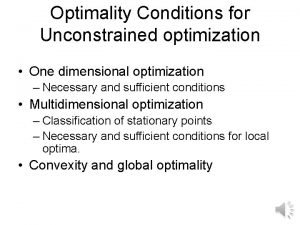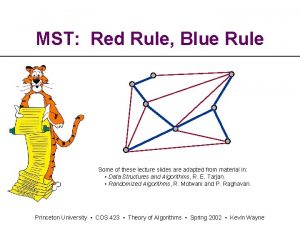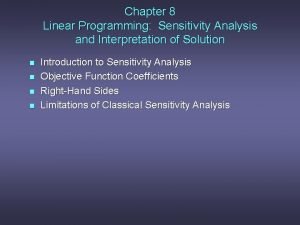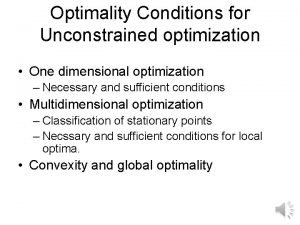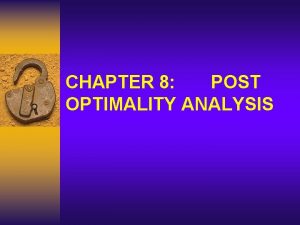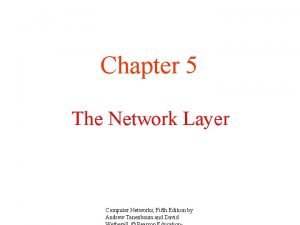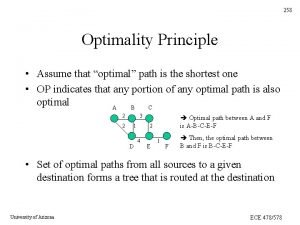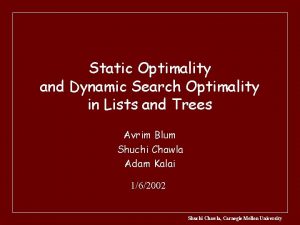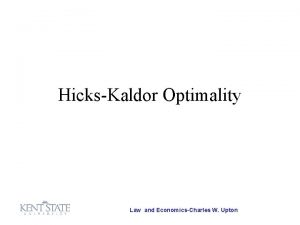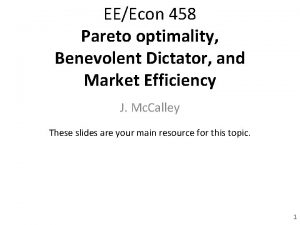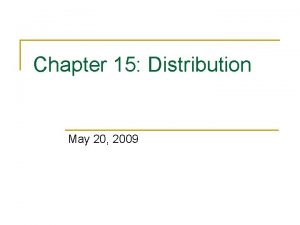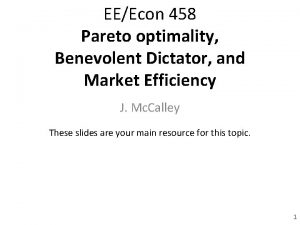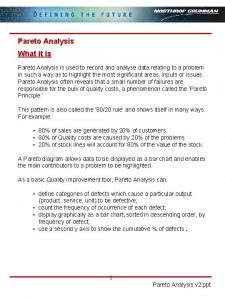Econ 4346 Test 1 Topic Review PARETO OPTIMALITY
















- Slides: 16

Econ 4346 Test #1 Topic Review

PARETO OPTIMALITY • An allocation of resources such that: • It is impossible to make at least one person better off without making someone else worse off • If two people are in a room, and one person has a full allocation of clothes… • And the other person a full allocation of food, then… • Trade will occur to a point where both people • Benefit from the interaction • Cannot improve any further without harming the other • Pareto Optimality serves as the basis for the Production Possibilities Frontier • Review video on blog http: //tc 6617. wordpress. com/2010/10/13/econ-4346 -basicprinciples-part-1/

(non) Pareto optimality EXAMPLE RECTANGLE REPRESENTS ECONOMIC CONSTRAINTS A B Two Economic players A and B. Non-Pareto Optimal, since there is room for both to improve

p. RODUCTION POSSIBILITIES FRONTIER • Displays efficient combinations of output when factors of production (labor, land, and capital) are used to full potential • Bowed shape represents increasing costs • In order to increase production of one good (A), production of the other (B) must be given up • Sounds like Pareto Optimality, perhaps? • Review Mankiw pp 25 -28 • Review blog: http: //tc 6617. wordpress. com/2010/10/13/econ-4346 basic-principles-part-1/

Production Possibilities frontier • Country can produce two goods: Grain and Wine • Bowed curve is the frontier. Any point on the curve is Pareto Optimal • Point ‘b’ is infeasible • Point ‘a’ is non-Pareto Optimal or ineffecient

Demand curve • Why is it downward sloping? • Because of the Law of Demand • The quantity demanded of a good falls when the price rises

Supply Curve • Why does it slope upward? • Because of the Law of Supply • The quantity supplied of a good rises when the price of the good rises

Equilibrium • A situation in which the market price has reached the level at which quantity supplied equals quantity demanded

Equilibrium of supply and demand P S Equilibrium D Q

Solving for equilbrium • Expedia did the following study (fictional) on its market for package tours • Demand schedule • Qd = 28, 000 – 300 P • Supply schedule • Qs = 23, 000 + 200 P • CALCULATE EQUILIBRIUM PRICE AND QUANTITY

Solving for equilibrium P Qs = 23, 000 + 200 P $10 Qd = 28, 000 – 300 P 25, 000 1. 2. 3. 4. 5. 6. 7. Q Set Qs = Qd 23, 000 + 200 P = 28000 – 300 P Solve for P 500 P = 5, 000 P = 10 Plug in value for P in one of equations (we’ll use Qd) 28, 000 -300(10) = Qd = 25, 000

PRICE CEILING • Occurs when government puts legal limit on how high the price of a product can be • Why? • Government thinks that price ceilings protect consumers • If government didn’t impose a price ceiling, the product wouldn’t be obtainable to the “average consumer” • Therefore unfair

Price ceiling P S CEILING SHORTAGE D Q Price ceiling below equilibrium. Shortage occurs because demand exceeds supply

Elasticity of demand • See figure 1, Mankiw, page 93 • Perfectly inelastic: Ed = 0 • Inelastic: Ed < 1 • Unit Elastic: Ed = 1 • Elastic: Ed > 1 • Perfectly Elastic: Ed = infinity

Elasticity of supply • See figure 5, Mankiw page 101 • Perfectly Inelastic: Es = 0 • Inelastic: Es < 1 • Unit Elastic: Es = 1 • Elastic: Es > 1 • Perfectly Elastic: Es = infinity

Shifts in supply and demand curves • Thoroughly review pages 67 – 82 in Mankiw
 What is optimality principle in computer networks
What is optimality principle in computer networks What is optimality principle in computer networks
What is optimality principle in computer networks Dynamic problem
Dynamic problem What is optimality principle in computer networks
What is optimality principle in computer networks A* optimality proof
A* optimality proof Optimality conditions for unconstrained optimization
Optimality conditions for unconstrained optimization Rule
Rule Range of feasibility
Range of feasibility One dimensional unconstrained optimization
One dimensional unconstrained optimization Post optimality
Post optimality The optimality principle in computer networks
The optimality principle in computer networks Optimality principle of routing
Optimality principle of routing General subject example
General subject example What are the steps in narrowing down research topic
What are the steps in narrowing down research topic Algebra 2 unit 1 test answers
Algebra 2 unit 1 test answers New global connections test answers
New global connections test answers Geometry topic 1 review
Geometry topic 1 review





